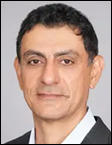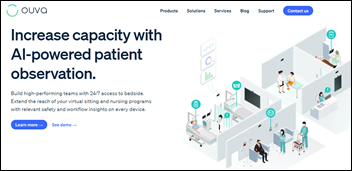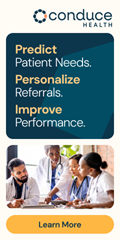Vivek Swaminathan is CEO of Cardamom Health.

Tell me about yourself and the company.
I like to think of myself as a technical generalist. My education is in electrical and computer engineering and business, but I’ve been in healthcare IT for 15 years and IT overall for over 20, some of that in manufacturing. I’ve been in leadership roles for 15 years and managed nearly every business functions that businesses typically have. Across all of that, I just love working with people and technology. I continue to be fascinated by both, and everything I’ve done has been with that in mind and the idea of trying to do something good and helpful for the world.
I started Cardamon knowing that we would be a little bit different than most businesses, but we had learnings and experiences that we wanted to apply. For example, we often see data analytics, applications, and operations in silos. I’m not saying that they don’t come together necessarily in certain situations, but they’re often not as collaborative as we would like them to be.
For the last 20-something years, we’ve had a huge focus on getting data in, whether it’s implementing a new system, looking at workflow, and doing optimization. But there’s been a lot of struggle to get that information out at the right time, make sure it’s actionable, and all those things that can make an impact. Meanwhile, I’ve watched consulting firms continue to focus on billable hours. Even if they do different things or try to come up with new models, it’s been about that margin spread per hour of billable work.
We wanted to do something a little differently. We are focused very much on team. We have a team that has data analytics and application experts who want those groups to work together so that we can focus on outcomes. That aligns incentives with our clients. You don’t have this situation where our consultants and our company want the most available hours possible, but the health system or the payer wants the fewest. Instead we focus on the results. What can we do together? What can we make contractual commitments around to get those results for our customers? That means there’s a variety of things that we do, from advisory or specific AI solutions to keeping the lights on and application management services. Our goal is to partner with our customers and find ways to make their lives easier and impact their results.
We focus on two areas. We want to enable the best outcomes for healthcare by maximizing the value of data and technology. The other is for our community. We want to foster an inclusive economy by growing a great, diverse team, but making sure that it also includes people who are overlooked or aren’t often given a chance. That’s how we’ve built this company.
How do you differentiate the company from other consulting firms?
It can be challenging to differentiate at times, often because the health systems that we work with have this tendency to think about staffing. They are used to picking a single person and employing them, or picking them and managing them, and they do progress reports for me. It can be challenging to work with them and find good ways to show value.
The way that we try to differentiate is to say, let’s focus on what it is that we’re trying to do and we can commit to those results. Often it’s at a fixed price instead of continually having hours grow. Often it’s the more complex areas, where you have to work across groups so that we can bring those different experts together. It might be an operational goal or a strategy. It might also just be that you have to work on something, but you don’t already know what your solution is or exactly how you want to approach it. Sometimes that’s how a traditional consultancy might come into play. Here’s this exact thing that I want you to work on. But we’re often trying to work on some of those more complex things, or those strategic initiatives, or the opposite, which is, “Just let me keep the lights on for you while you go do that.”
How is starting and running a business different from your previous roles with Epic and Nordic?
I will say that it is not for the faint of heart. It has been fun for sure. There have been a ton of learnings. I thought that having been through a lot of different roles that I understood the wide array of things that could happen in any given day in any given hour as you jump from one meeting to another or one subject to another. But it’s exponentially more dramatic when you’re in pure startup mode and you’re jumping from dealing with some insurance issue to then helping a customer and then working on something financial in your cash flow.
It’s kind of all over the place, which has been invigorating because I love variety and change, and I find it exciting. But it’s challenging and can be nerve-wracking at times as you have to think about cash flow every day. I’m not the type of person who focuses a lot on money a lot, and every day you have to think about that next deal in a more substantive way than when you’re already a $50 million company. It has been a wild ride, but I have fully enjoyed it.
When investors are involved, the focus is often scaling the business up. Is that harder to do with a services business?
I’m not sure that it’s necessarily harder. It’s definitely different. Having worked for both software companies and service companies and having businesses where you have a little bit of both, you have to approach it differently. With software businesses, you’ve done a lot of the R &D work upfront, and a lot of that money or investment is about getting something created or a proof of concept, things like that. On the services side, there’s this balance where you are focusing on these pre-revenue people, but also sometimes they are partially pre–revenue and they’re partially post–revenue.
The challenges and the conversations when you’re bringing in money about what to do next and how to use it can be challenging. There’s a lot more discussion around how much to raise. I try hard to make sure that we are bringing in good investment, not bad investment, where you make sure that you have the right partners that are aligned to where you’re trying to go. Otherwise, you get forced into situations where they wanted to put more money in and now you have to spend it. Maybe you’re not spending it on the right things, and you’re in this perpetual loop of raising more and raising more and raising more.
Our goal is to find ways to keep that in check. You can always hire people. It’s not that hard to look out there and say, that person’s great, why not hire them? This perpetual balance or back and forth of saying, this is the time to do it. This is exactly what we’re going to use the funds for so that you can grow in a controlled way, but always be ready to grow quickly. That’s what I look for on the the services side.
What’s it like to run a company like yours in Madison?
It’s especially interesting having grown up here. What the environment is like now is nothing compared to what it used to be. Epic and the other successful organizations around here get credit for it. I feel very supported here in terms of having an ecosystem and an environment in which you can find other people to work with, who can give advice,and who are willing to help each other out.
Historically, there have been fewer opportunities to raise funds here, but HealthX Ventures is a great. They are our partner, so obviously I’m biased, but they’re a great example of a group that is tapped into our community and wants to change that and put more money into organizations here. There are others doing that as well.
There’s more visibility now in Madison, and there are more people looking here than there ever have been. I certainly have felt that support. But out of all the groups I talk to, by far the most people who are interested in investing or being a part of this are not in Madison.
What are some interesting ways that people are using EHR data?
I see it in your AI updates. There are plenty of cool, interesting things that are happening out there, especially from various software companies or product organizations. I actually get more excited about the functions that are almost administrative. We have some. We created an LLM that’s focused on the bloat that has been happening around reporting and analytics, and how can you analyze that quickly and look at what’s redundant. What isn’t? Where can you do cleanup?
I’m a little bit of the dork on the support side, where it’s like, “How can we bring down the number of things that we’re managing and supporting? How can we clean it up and then make sure we don’t have so many duplicates and things like that?” I don’t hear as many people talking about it, but I think it’s low-hanging fruit that’s out there that needs to be addressed, and there are multiple versions of that kind of use case.
Searching, of course, is another one. We think about our Google searches or Gemini or whatever it is out there. But there’s a lot of benefit from using some of these things for searching or self-service. I almost think of the analogy to the service desk and a lot of the initiatives in the service desk world around self-service and moving work left and all of those kinds of things. A lot of that be can be done in the AI and data world.
Do you feel an urgency to do something with AI because it’s popular?
It is a strategy. We definitely get a lot of questions about it. Certainly investors are asking questions about it and want to pressure you that way. But customers are very interested in it, and we have had it as a strategy. When we’re focusing on data analytics and applications, there’s no question that’s they are a part of that world.
However, we’re not trying to be AI product company. We’re not trying to go out there and say, “We’ve done this one thing, and now let’s resell it all over.” Because I think that you have to meet the customer where they are, and customers are at all different levels and they have different early pain points. I think it’s more valuable to have wraparound services and using AI when it makes sense. There are times to use it when it can bring down the people hours so that you can bring down the cost and the time to value. For me, those are no -brainer situations to start using AI and to lump that in with whatever services that you’re using. Similarly, there’s automation and other things that we can do in that respect.
I don’t feel a strong push or desire to be an AI company, per se. It’s just not who we are or what we’re trying to be. But I definitely think we would be doing ourselves a disservice if AI wasn’t a part of our strategy and how we do business.
How has consulting changed after services moved to remote rather than on site during the pandemic?
There has been a lot of change over the last few years, certainly since COVID. I remember 10 or 15 years ago having conversations with customers about asking for people to be able to have one week remote a month. It was a real challenge to get people to accept that. People didn’t necessarily trust that work could be done remotely. I think we’re past that now. For the most part, people understand that you can do work remotely.
It doesn’t mean all the organizations have changed their decision-making on whether they are allowing for remote work. I also recognize there’s some of that as challenges with having to be registered in multiple states and all those kinds of things, but not everybody has accepted that. However, the vast majority I think have, and what we’ve found is that now you have this national marketplace for people, and there’s even more competition for talent. Certain organizations in certain parts of the country have more money and are able to command or pay for the best talent, and it can become challenging for people. It has put a magnifying glass in some of these things that have been around for a while, and now you’ve got more competition for talent, more organizations that are just struggling.
We have customers we work with that have six or seven open positions on one team, let alone across a larger group of IT, and they’re just not able to hire or keep people. That continues to create opportunity for us because we can be helpful to our help systems by having this team for them. It also allows them to maybe hire or get work not to their maximum amount of capacity they need during their peak times, but maybe bring somebody else like us in just to make sure the minimums are covered, and then work with others to scale up and scale down as needed. More and more organizations are opening up to that idea, and nearly everybody I talk to has bought into the concept, but I haven’t necessarily seen everybody be able to actually get it through their processes and make good on it. We’re in an in-between phase right now, but I think that’s where the industry’s going.
What Epic-related work is popular?
New applications continue to be an area of interest. Things like Payer Platform, which has become a bigger thing, especially with small payers or health plans. Part of why we’re working in this data and analytics space is that Epic did a lot to improve their toolset and add functionality in the past five or 10 years, and nearly every health system we talk to says they know that they are not fully utilizing them. Most aren’t there even things like self-service, where they know they can use Slicer Dicer to offer more real-time reports for end users. So a lot of what we’re seeing, and I don’t know that I’d call it optimization, is that if you already own Epic, let’s utilize it to its full extent. That’s the biggest part. There are other things like Cheers when you’re looking at patient experience and campaigns that people are excited about as well.
What do you see as important for the company’s strategy in the next handful of years?
Certainly being an early stage company, we have to think about financials and making sure that we are self–sustaining. We aren’t trying to be the type of organization that has financial backing that then is always raising capital again and again and again. We need to make sure that we are always in a good spot there. As time progresses, we will continue to improve there and be able to make the right investments for our customers so that we are ahead of the game and ready as they need us, which gets to the customer side. We want to make sure that we are making positive lasting impact for them, applying learnings. Hopefully we’re the top partner for many of our health systems that we’re working with. I certainly hope that people are thinking about this approach and are trying this data and analytics and applications together concept, as we are kind of the glue between it, we’re doing managed services for them, and they are seeing the value so that they can focus on their strategic initiatives.
The last thing, and it’s super important to us, is making sure that our team and our culture continue to grow and thrive. We have to bring the right people on board. That’s always a focus for us. It takes work always to have a great culture, and we’re going to do that. We are never going to skimp on that. Three, four years from now, we’re going to be utilizing those economies of scale, the larger team, to be able to do more for our customers in a way that just makes life easier for them.
I challenge myself all the time with this. Let’s all keep learning. Let’s embrace change. I’m a big believer in incremental improvement. Let’s all find ways to make that incremental improvement to slowly move in the direction that we need to go. Obviously, we need to keep people at the center of all this. Let’s not forget that. Let’s not forget our patients that are out there. Let’s not forget our own staffs. Let’s not forget those people that we interact with, whether they’re partners or vendors or whomever else. Above everything else, if we keep people at the center and we keep challenging ourselves to improve, we are going to make tremendous progress in healthcare. So thank you to everyone who is already doing that.
Comments Off on HIStalk Interviews Vivek Swaminathan, CEO, Cardamom Health


















































































































































Hard agree with "actionless figure" - I realize that LinkedIn is the only mostly-non political form of social media we…